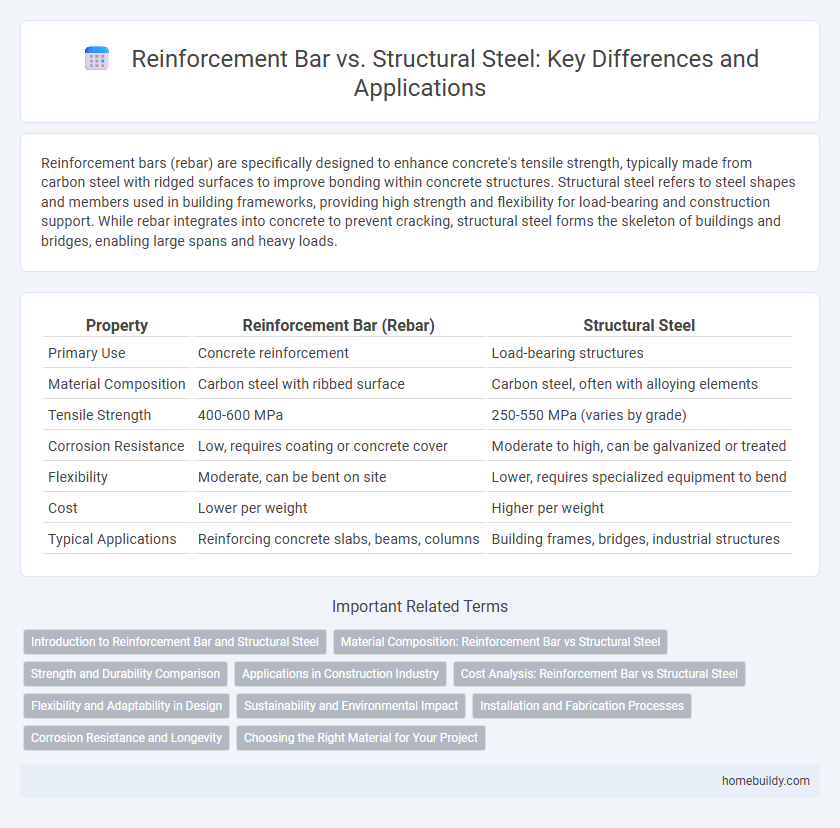Reinforcement bars (rebar) are specifically designed to enhance concrete's tensile strength, typically made from carbon steel with ridged surfaces to improve bonding within concrete structures. Structural steel refers to steel shapes and members used in building frameworks, providing high strength and flexibility for load-bearing and construction support. While rebar integrates into concrete to prevent cracking, structural steel forms the skeleton of buildings and bridges, enabling large spans and heavy loads.
Table of Comparison
| Property | Reinforcement Bar (Rebar) | Structural Steel |
|---|---|---|
| Primary Use | Concrete reinforcement | Load-bearing structures |
| Material Composition | Carbon steel with ribbed surface | Carbon steel, often with alloying elements |
| Tensile Strength | 400-600 MPa | 250-550 MPa (varies by grade) |
| Corrosion Resistance | Low, requires coating or concrete cover | Moderate to high, can be galvanized or treated |
| Flexibility | Moderate, can be bent on site | Lower, requires specialized equipment to bend |
| Cost | Lower per weight | Higher per weight |
| Typical Applications | Reinforcing concrete slabs, beams, columns | Building frames, bridges, industrial structures |
Introduction to Reinforcement Bar and Structural Steel
Reinforcement bars, commonly known as rebar, are steel bars embedded in concrete to enhance its tensile strength, playing a crucial role in reinforced concrete structures. Structural steel, in contrast, refers to steel shapes and sections used as primary load-bearing elements in frameworks, offering higher ductility and load-bearing capacity. Understanding the distinct properties and applications of reinforcement bars versus structural steel is essential for optimal design in construction engineering.
Material Composition: Reinforcement Bar vs Structural Steel
Reinforcement bars, primarily composed of carbon steel with varying levels of carbon, manganese, and silicon, are designed to enhance tensile strength and bond effectively with concrete. Structural steel typically contains a higher proportion of carbon and alloying elements such as chromium, nickel, and molybdenum, providing greater durability, toughness, and resistance to environmental factors. The distinct material compositions influence their performance characteristics, where reinforcement bars prioritize flexibility and adhesion within concrete, while structural steel focuses on overall strength and resilience in load-bearing frameworks.
Strength and Durability Comparison
Reinforcement bars (rebars) exhibit high tensile strength, ranging from 400 to 600 MPa, which enhances concrete's load-bearing capacity, while structural steel typically offers tensile strengths between 250 and 550 MPa, depending on grade and composition. Rebars are designed with ribbed surfaces to improve bonding with concrete, significantly increasing durability under cyclic loads and corrosive environments when properly treated. Structural steel provides superior uniformity and toughness but requires protective coatings to prevent corrosion, making reinforcement bars more cost-effective for concrete reinforcement with enhanced longevity.
Applications in Construction Industry
Reinforcement bars are primarily used to enhance the tensile strength of concrete structures, making them essential in foundations, beams, and slabs where concrete alone is weak under tension. Structural steel offers versatility and high load-bearing capacity, often applied in frameworks of high-rise buildings, bridges, and industrial structures requiring robust support. The choice between reinforcement bars and structural steel depends on specific structural requirements, load conditions, and design preferences within the construction industry.
Cost Analysis: Reinforcement Bar vs Structural Steel
Reinforcement bars typically offer a lower cost per unit compared to structural steel, making them economically favorable for concrete reinforcement in construction projects. Structural steel incurs higher production and fabrication expenses but provides greater strength and versatility for building frameworks. Evaluating lifecycle costs reveals reinforcement bars as cost-effective for load-bearing concrete components, while structural steel suits applications requiring superior tensile strength despite increased initial investment.
Flexibility and Adaptability in Design
Reinforcement bars offer superior flexibility and adaptability in design compared to structural steel due to their ability to be easily bent and shaped on-site to meet complex architectural requirements. Their varying diameters and lengths allow for customized reinforcement solutions in concrete structures, enhancing load distribution and durability. Structural steel, while strong and uniform, lacks this level of malleability, making reinforcement bars more suitable for intricate and dynamic design applications in construction.
Sustainability and Environmental Impact
Reinforcement bars (rebar) made from recycled steel significantly reduce environmental impact compared to structural steel, as they require less energy for production and lower raw material extraction. The durability and corrosion resistance of high-quality rebar extend the lifespan of concrete structures, minimizing resource consumption and waste generation over time. In contrast, structural steel often involves higher carbon emissions during manufacturing, making rebar a more sustainable choice in reinforced concrete construction.
Installation and Fabrication Processes
Reinforcement bars, commonly known as rebar, require bending and cutting tailored to the concrete framework during installation, which involves precise placement to ensure optimal structural integrity. Structural steel fabrication demands advanced processes such as welding, bolting, and machining, highlighting the need for skilled labor and specialized equipment. Installation of structural steel often entails lifting and securing prefabricated components, contrasting with the more manual positioning of rebar within concrete forms.
Corrosion Resistance and Longevity
Reinforcement bars, typically made of carbon steel, exhibit lower corrosion resistance compared to structural steel alloys designed with protective coatings or weathering properties. The longevity of reinforcement bars in concrete depends largely on adequate concrete cover and proper anti-corrosion treatments, whereas structural steel components often incorporate surface treatments like galvanization or paint systems to extend lifespan in exposed environments. Advances in epoxy-coated and stainless steel reinforcement bars improve corrosion resistance, narrowing the durability gap with structural steel in aggressive conditions.
Choosing the Right Material for Your Project
Reinforcement bars, or rebar, provide essential tensile strength specifically designed for concrete structures, ensuring durability and resistance to cracking under load. Structural steel offers higher flexibility and load-bearing capacity, making it suitable for frameworks requiring complex shapes and heavy-duty applications. Selecting between reinforcement bars and structural steel depends on project requirements such as load type, environmental exposure, and structural design complexity.
Reinforcement bar vs Structural steel Infographic

 homebuildy.com
homebuildy.com